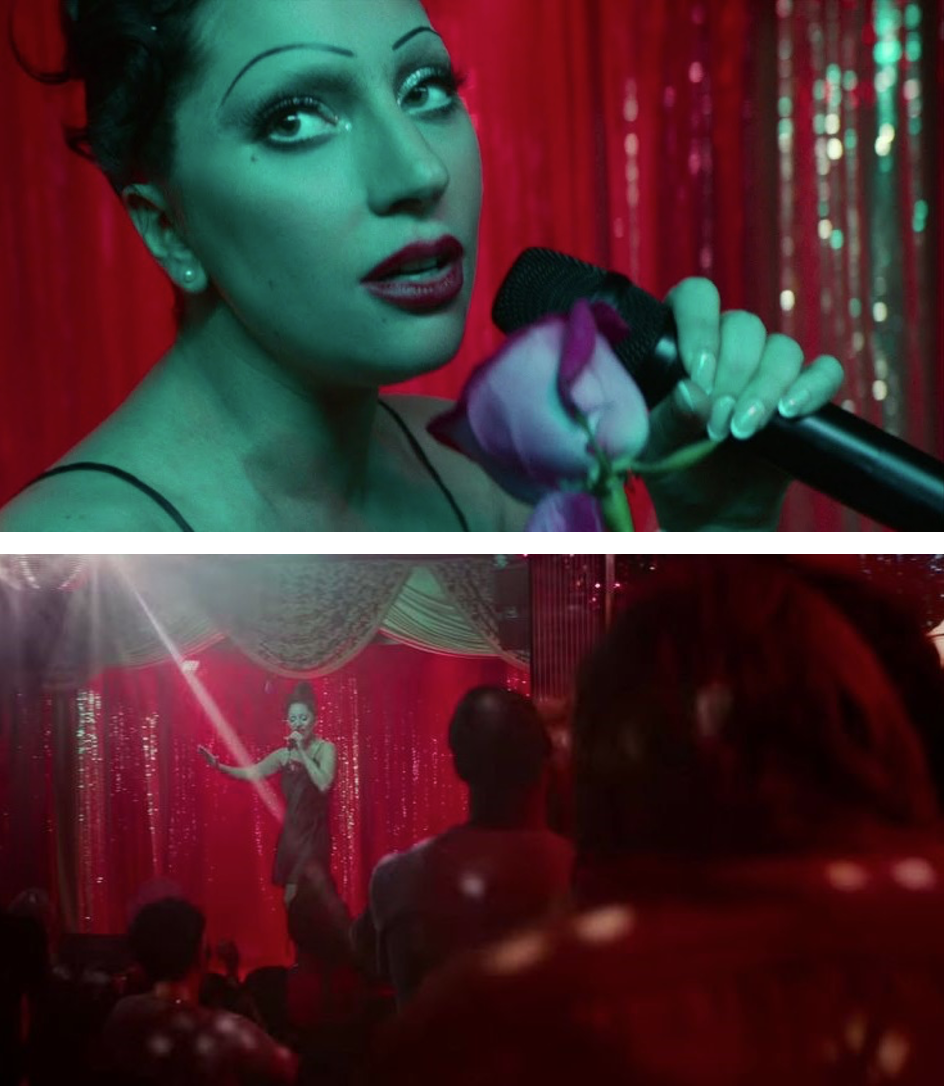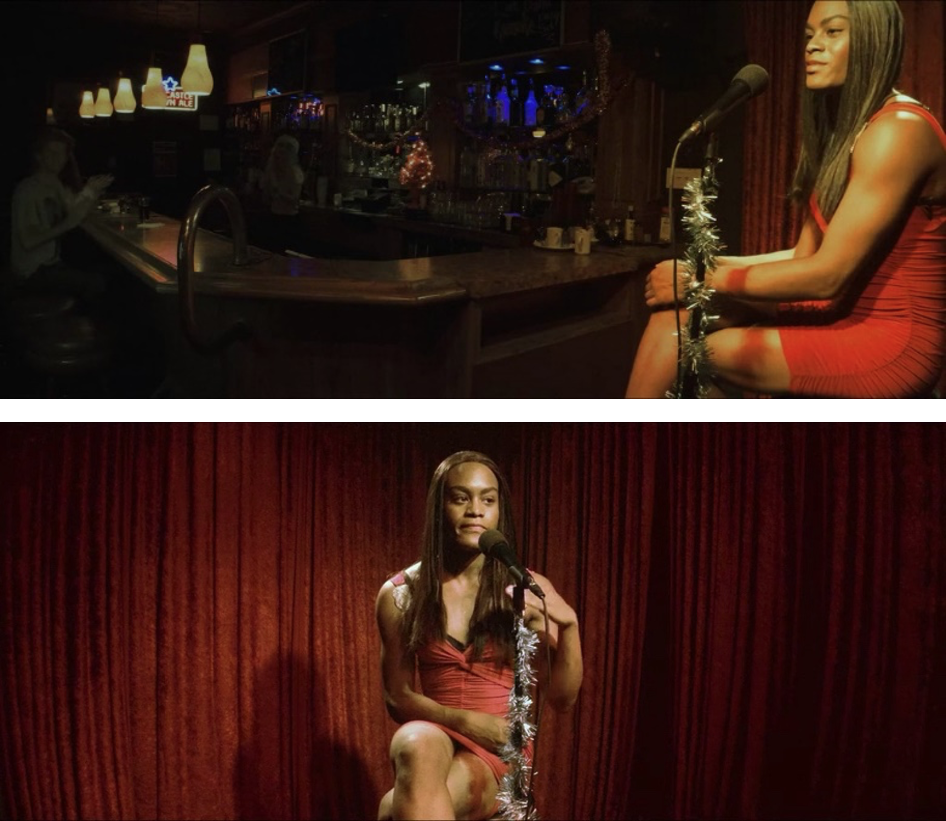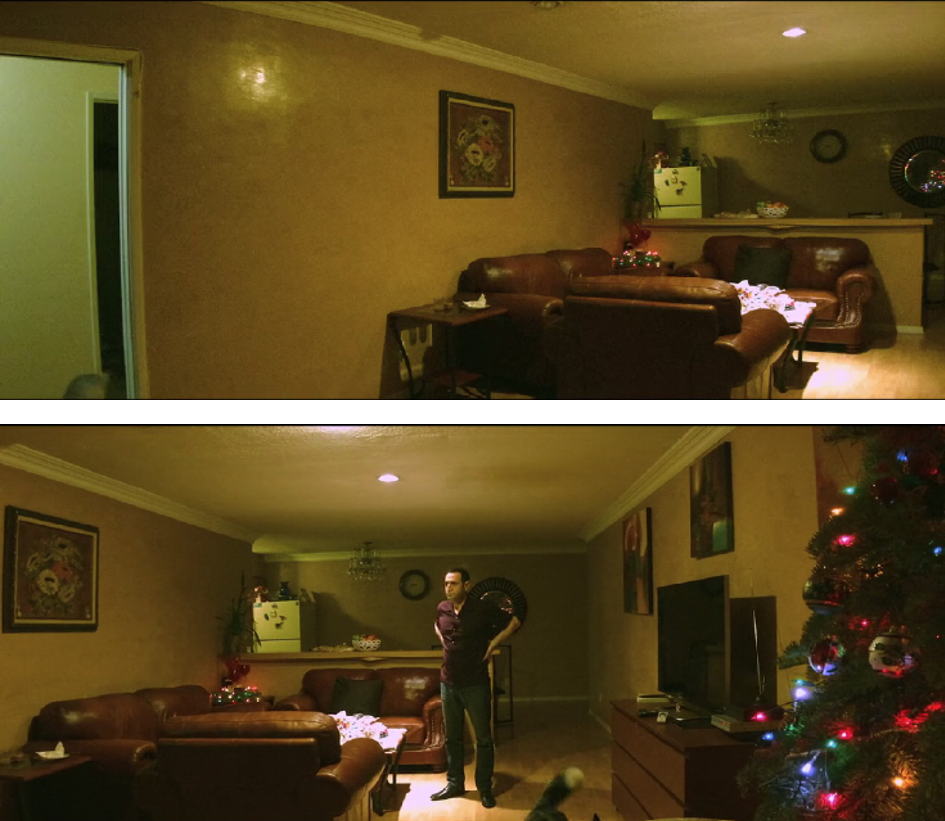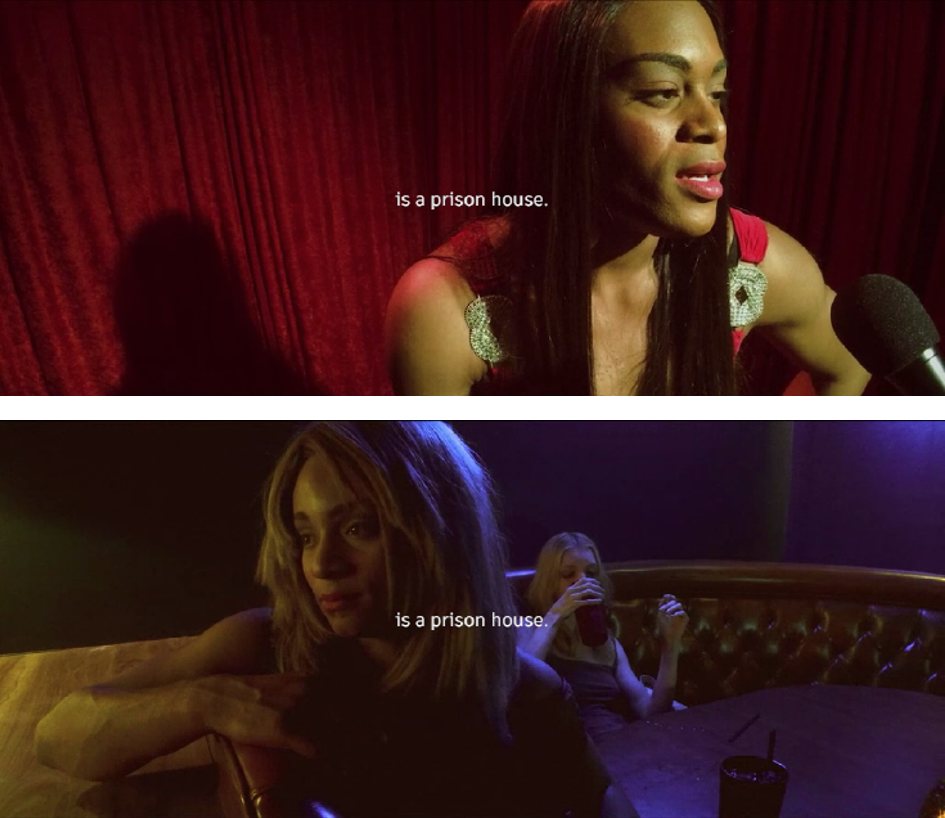Toyland, toyland / Little girl and boy land
While you dwell within it / You are ever happy there
Childhood's joy land / Mystic merry toyland
Once you pass its borders / You can ne'er return again
- Victor Herbert and Glen MacDonough, Toyland, (Chicago : M. Witmark and Sons, 1903), 3.
Introduction
Sean Baker’s Tangerine (2015) set in Hollywood, Los Angeles, California, is a film about thresholds. The narrative, which follows a day–and night–in the life of two black transgender sex workers named Sin-Dee Rella (Kitana Kiki Rodriguez) and Alexandra (Mya Taylor), ushers the viewer along the wide boulevards and hidden niches of the neighborhood. Throughout their journey, Baker offers a cinematic framing of Hollywood that challenges its assumed associations with American cinema and celebrity culture to depict a much more brutal reality on the ground. However, Tangerine remains a lighthearted film despite the adversity that Sin-Dee and Alexandra face in their day-to-day.[1] The reality of the two characters’ experiences is presented alongside moments of fantasy that show the love, care, and hopes that they share and hold close. Using José Estaban Muñoz’s Cruising Utopia: The Then and There of Queer Futurity (2009), I focus on Alexandra’s performance of “Toyland” to demonstrate how the gay bar as a typology of urban queer nightlife has fostered, to a degree, a safe space for the LGBTQ+ community. Furthermore, the framing and scale of the stage, performer, and audience are compared with scenes from two other films which borrow from the same classic Hollywood stage aesthetic to highlight the particularities of Alexandra’s rendition as an act of queer place-making in a rigidly defined city. Lastly, I explore the effect of overlaying text from Cruising Utopia onto the same “Toyland” scene to illustrate how the characters in Tangerine fail or succeed in reaching into the fantasy world(s) that they dream of.
Locating Tangerine
Like Baker’s The Florida Project (2017) set in Kissimmee, Florida, Tangerine is very much grounded in the place is it set and filmed. The film begins on the corner of Santa Monica Boulevard and Highland Avenue in an area known as an unofficial red-light district. In an interview, Baker speaks to how this exact location which was just half a mile away from where he was living when he first moved to LA was shocking in that it demonstrated a completely different version of the city than he initially would have expected; he goes on to say that much of city, in actuality, is a departure from what is constructed on the big screen.[2]
Sin-Dee and Alexandra’s experience of this environment is supported by Mike Davis’ City of Quartz (1990) which provides a framework of urban analysis in LA that situates the various locations pictured in the film as hostile zones of confinement. In the text, Davis affirms Baker’s intuition and explores the cityscape as an omni-oppressive matrix of security that has largely destroyed public spaces to shield so-called “respectable people” from other “unsavory groups” (such as our main characters).[3] The lack of public space in Tangerine is perhaps not so evident at first. Initially, Sin-Dee and Alexandra seem to make their way around Hollywood with a certain degree of agency and confidence. However, as the film progresses, the locations visited by the characters paint a different picture–especially as they begin to return to the same key locations–revealing the spatial networks that they have become familiar with due to the top-down limits placed on them by the city. Furthermore, the pseudo-public spaces that exist in between private spatial networks remain unwelcoming environments that thrust the two protagonists into constant mobility. Davis concludes that the “crusade to secure the city” has rendered the limited public spaces that border the boulevards in LA largely uninhabitable to pedestrians.[4] Throughout the film, Sin-Dee and Alexandra spend much of their time moving from place to place either on foot or by riding on public transport (without paid tickets). The two never stick around in any one place for too long though, a subtle hint that there might not be anywhere for them to stick around. When Sin-Dee has a moment of pause on a bench in front of a bus stop in the blazing hot sun, her impatience and anxiety mount as more and more people flood into the space around her. Even when returning to familiar places like Donut Time, their stay is limited by the function of the shop as a commercial/private space. In these examples, Sin-Dee and Alexandra are pushed to leave both public and private spaces due to a lacking sense of security in the former and the disruption they cause (during the climax of the film) in the latter.
Toyland & Queer Futurity
As mentioned before, Tangerine manages to balance the crudeness of Hollywood with moments of joy and beauty. One of these moments is Alexandra’s performance of “Toyland,” a vintage Christmas song originally written by Victor Herbert and Glen MacDonough for the operetta Babes in Toyland (1903). Up until this point, the characters and thus narrative of the film have moved at a quick pace–from donut shops to boulevards to restaurants to motels to buses and now, a bar. The remarkable stillness of this scene is a moment of pause that explores the stage as a site of queer placemaking through performance and demonstrates how it is utilized to cope with and reject the urban systems outlined in Davis’ text. In Cruising Utopia: The Then and There of Queer Futurity (2009), José Estaban Muñoz positions queerness in a speculated futurity, a then and a there, and analyses the role and function that performance stages in particular play in the queer imagination. He writes the following:
Capitalism, for instance, would have us think that it is a natural order, an inevitability, the way things would be. The “should be” of utopia, its indeterminacy, and its deployment of hope, stand against capitalism’s ever-expanding and exhausting force field of how things “are and will be.”[5]
LA’s urban planning insists that those at the margins accept a perceived notion of reality as fixed, and unchangeable. At the start of the film, when the two friends meet at Donut Time following Sin-Dee’s release from prison, Alexandra exclaims, “Out here it is all about our hustle, and that’s it.” Their hustle is the here and now, the how things are and will [always] be. Despite Alexandra being the one to utter these words, she contradicts herself during her rendition of “Toyland.” The “Toyland” scene takes place in Hamburger Mary’s located on Santa Monica Boulevard and Sweetzer Avenue in West Hollywood. In real life, Mary’s is a popular queer-friendly space that regularly hosts drag shows and other events catered to the LGBTQ+ community.[6] In Tangerine, Mary’s stage is activated by Alexandra not only to reject and cope with her current reality but to imagine a fantastical version of herself.


Scene and Stage Analysis
The scene opens with an establishing medium shot of Alexandra seated on a stool on the stage. Alexandra, wearing a red dress with silver accents on the straps, is placed in front of a microphone stand decorated with silver tinsel and behind red velvet curtains which encompass most of the frame, giving the impression that the stage extends beyond our narrowed view. Warm stage lighting illuminates downward from the ceiling onto Alexandra’s figure, casting a shadow of her silhouette on the stage curtains. As Alexandra sings, the frame shifts momentarily to Sin-Dee and Dinah who are seated in a booth a couple of meters away from the stage. Sin-Dee, who appears transfixed by the performance, is bathed in a warm light emitting from the stage on the left. Behind her is a blue light that covers most of the booth seating as well as Dinah. Other close-up and extreme close-up shots of Alexandra are sprinkled throughout her performance.

The mise en scène instantly recalls a classic old Hollywood stage performance aesthetic referenced in movies like Bradley Cooper’s A Star Is Born (2019) and David Lynch’s Blue Velvet (1986). The story told on Tangerine’s stage is much different, however, to those in the aforementioned films. In ASIB, the main character of Ally (Lady Gaga) covers “La vie en rose,” a song originally sung by Édith Piaf. While the shots in Ally’s sequence from ASIB might resemble Alexandra’s in Tangerine, there are many key differences. In ASIB, Ally’s face is washed in a green light and is in deep contrast to the red stage curtains behind her. Unlike Alexandra, whose red dress establishes a continuity with the backdrop, Ally stands out from her environment. This frames Alexandra’s performance as much more timid than Ally’s. Additionally, we are rarely shown Ally singing on the stage itself. While performing, she maneuvers her way through the crowded bar (which also so happens to be set in LA just east of Hollywood) as the stage lingers behind her. In a sense, the film attempts to communicate that Ally is destined for something bigger and better, that she can permeate the barrier between the present (real) and the potentiality of the future (fantasy). Alexandra on the other hand is confined to the parameter of the stage and thus the extent to which that fantasy she imagines can be sustained beyond the performance.
Scale also has an impact on the framing of a scene as seen in the “Blue Velvet” performance from the film of the same name. The “Blue Velvet” sequence is shot at a greater distance from the stage than the two other films. Lynch focuses on presenting the audience (both seated in theatres and the world of the film) with an impressive show featuring a dramatic introduction, dynamic stage lighting, and a live band. The camera does approach the singer quite closely towards the end of the sequence, but it never quite reaches the same intimacy that ASIB and Tangerine do. Furthermore, Lynch isolates the stage from the audience. The performance in Blue Velvet is interrupted frequently by medium shots of the film’s protagonist accompanied by his love interest who are never framed with the stage, further isolating the two dimensions of real and fantasy from each other. In Tangerine, many frames in the sequence include, or rather expose the space surrounding the stage, constantly shifting the position of the viewer in and out again of the portrayed fantasy. The choice to shoot the entirety of the film using an iPhone 5S permits this compositional framing. The film was shot using three different iPhones but only two were ever used at the same time. As elaborated in many interviews with Baker, shooting on an iPhone meant that they could more easily maneuver into



tight spaces and crowded places without having too much of a physical footprint.[7] The wide lens of the iPhone camera has no problem in approaching Alexandra’s figure during her performance. However, perhaps a unique element of shooting on the iPhone is its field of depth. Unlike the two other performance sequences where the professional cameras feature a shorter depth of field, bringing a greater focus to the subject on the screen and cropping the visibility of the background, the performance sequence in Tangerine can reveal much of the space surrounding the stage while still in proximity to Alexandra.
The recurring use of a compositional split screen further imparts the idea that Alexandra and Sin-Dee are caught between the real and the reel as Baker positions the characters in a space between the world of reality and that of fantasy by dividing the composition of the frame in two (as seen in Fig. 3a, right image). Eventually, the final shots of the “Toyland” sequence bring attention to the return to reality.

Alexandra’s performance ends with a shot almost identical to the opening shot of her on stage, except now the lighting and colors are made muddier–a departure from the rest of the scene and the entirety of the film–demonstrating a break in the psyche of Alexandra that signifies the interruption of her escape. This effect continues into a shot of Alexandra as she receives sporadic claps from the audience. Her figure, as well as the glimpse of the stage curtains that we get, are condemned to the very right of the frame as the almost empty bar swallows and overwhelms the rest of the frame.
Visual-textual Exercise
I continued to explore queer futurity in the “Toyland” scene through the task of juxtaposing a selected text within a 3-minute continuous clip from my chosen film. The key feature of this exercise, which resulted from the imposed time constraint, was that I could include more than just the “Toyland” performance (the full performance of “Toyland” sits at about 2 minutes and 30 seconds). This led me to also include the scene with Razmik at home in his bathroom which I argue is presented as a foil to Alexandra at the bar on stage. Throughout the clip, the excerpt from Muñoz reinterprets and reaffirms the narratives of Razmik, Alexandra, and Sin-Dee relevant to the interiors that they inhabit:
Queerness is not yet here. Queerness is an ideality. Put another way, we are not yet queer. We may never touch queerness, but we can feel it as the warm illumination of a horizon imbued with potentiality […] The future is queerness’s domain. (Razmik) Queerness is a structuring and educated mode of desiring that allows us to see and feel beyond the quagmire of the present. The here and now is a prison house. (Sin-Dee) We must strive, in the face of the here and now’s totalizing rendering of reality, to think and feel a then and there. (Alexandra) [8]
Queerness, according to Muñoz, is not so much defined by an identity as it is a mode of seeing, experiencing, and navigating the world outside the current status quo. In both scenes (Razmik in the bathroom and “Toyland”), the characters are confronted by the contradiction of the present and the future as they struggle or succeed in reaching that future that they envision. Starting with the first scene, Razmik exemplifies a character teetering the line that crosses into the future but never fully reaches it. The cab driver is shown to live in a humble residence: the ceiling is quite low, the kitchen is placed directly in front of the entrance, and the couches and coffee table in the living room doubly serve as dining room furnishings. A brief glimpse towards the hallway leading into the child’s bedroom, primary bedroom, and bathroom is also shown.

Although the position of the bathroom relative to the other living spaces is not made entirely clear, audio cues suggest that it is not too far from the living room. Still, the space of the bathroom provides Razmik with privacy that is otherwise not afforded in the rest of his family’s residence. The bathroom, like the rest of the house, is a small, confined space, made evident by the consistent proximity of the subject to the camera throughout the scene. While mirrors can and are often used in cinema to extend space, here the mirror is used to reflect reality back at the subject that stands in front of it, denying other potential possibilities. In the case of Razmik, his reflection in the mirror is a reinforcement of his internal conflict with his own life, including his vices, relationships, employment, etc. When Razmik enters the bathroom to refresh himself, the mirror takes up a considerable portion of the frame right up until he dries his face using a towel, and then returns as he pulls and opens a folded invitation to Alexandra’s performance from his back pocket, taking up a majority of the frame. Razmik, as a closeted character, is caught in a struggle between reality and that “warm illumination of a horizon”. Contrastingly, the following “Toyland” scene highlights how Alexandra and Sin-Dee utilize (queer) performance to project themselves into new self-imaginings beyond their current reality. While Razmik's desires are whispered quietly in the privacy of the bathroom, Alexandra loudly declares a vision of herself to the public audience. “Look at me! I am here, and don’t I look fabulous,” she might say.
Throughout this exercise, text is used to emphasize actions or emotions in the given mise en scène. For example, the text, “Queerness is an ideality. Put another way, we are not yet queer” appears in the frame just as Razmik looks into the mirror after rinsing his face and disappears after he dries his face in his towel and looks back into the mirror as if he could briefly imagine himself in another existence, another house, another family, another place. Other techniques are also used to bring more emphasis to specific phrases. The clip opens and closes with sound only, bringing attention to the text more directly without completely removing it from the context of the film. Additionally, text only appears over the shots with Sin-Dee during the “Toyland scene”, connecting the textual narrative to her character while also framing Alexandra’s performance indirectly.

One exception is made towards the end of the song. The words “is a prison house” appear in a shot of Alexandra and continue onto the following shot of Sin-Dee, emphasizing that both characters are trapped by their circumstance and relate to each other in that way.
Conclusion
To be queer is to reject the here and now and insist on the potentiality, or possibility, of another world. It is through this insistence that Sin-Dee and Alexandra are able to cope with their present reality, as demonstrated in the first half of the film as they wander, sometimes with agency, often aimlessly, along the unwelcoming streetscapes in Hollywood. The “Toyland” scene, borrowing from the same Hollywood aesthetic explored in other contemporary films like A Star Is Born and Blue Velvet simultaneously demonstrates the potential of Alexandra’s performance in realizing her own self-image as a grande chanteuse as well as the limits of the exercise. In a world that constantly reinforces itself, projects onto you and your body tells you what you can and cannot be and where you can and cannot exist, Sin-Dee still finds Alexandra despite being in the middle of a chaotic adventure at Mary’s on Santa Monica to share a moment of mutual catharsis. The stage, lighting, framing, and scale all work to keep Alexandra within a liminality wedged between the present and the future.
Tangerine makes the argument that the existence of places like Hamburger Mary’s can foster and provide space for queer and trans people to present themselves as who they want to be, not necessarily as the people they might be right now. The queer nightlife scene is also revealed to be a crucial element in the lives of both characters. The performance is perhaps the only piece of the film that we as viewers could expect to happen from the first few moments in the film; Alexandra does not miss a chance to remind others in the community of her one-woman show as she spontaneously encounters them throughout Hollywood. Of all the locations shown in the film, the bar might be the most important in that it shows us a glimpse into what life could look like for these characters–the moment when the then and there meets the here and now.
[1] Mya Taylor reveals in an interview with BUILD in 2015 that she joined the cast of Tangerine on two conditions: that it be “real and raw,” and funny.
[2] Film at Lincoln Center, “Tangerine Q&A | Sean Baker,” YouTube Video, 23:26, November 10, 2015, https://www.youtube.com/watch?v=36QG5M5UOkg&ab_channel=FilmatLincolnCenter.
[3] Mike Davis, City of Quartz: Excavating the Future in Los Angeles (London: Verso, 2006), 224, 231-232.
[4] Davis, 226.
[5] José Estaban Muñoz, Cruising Utopia: The Then and There of Queer Futurity (New York: New York University Press, 2009), 99.
[6] “Hamburger Mary’s – West Hollywood,” https://www.hamburgermarys.com/weho/.
[7] DP/30: The Oral History of Hollywood, “DP/30: Tangerine, Sean Baker, Kitana Kiki Rodriguez, Mya Taylor,” YouTube Video, 33:49, July 7, 2015, https://www.youtube.com/watch?v=Fl35nOvAmjw&t=1169s.
[8] José Estaban Muñoz, Cruising Utopia: The Then and There of Queer Futurity (New York: New York University Press, 2009), 24.
